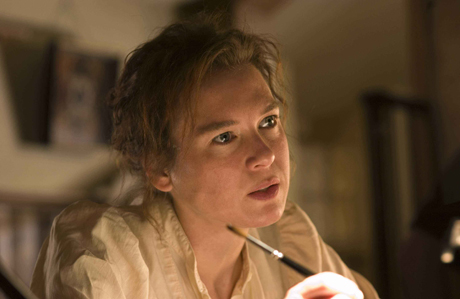« Rocky Balboa (2006) – Movie Review | Home | Pan’s Labyrinth (2006) – Movie Review »
Miss Potter (2006) – Movie Review
By Robert L. Jones | December 30, 2006

Renée Zellweger as Peter Rabbit's creatrix in "Miss Potter"
Color Me Charmed
[xrr rating=4/5]
Miss Potter. Renée Zellweger, Ewan McGregor, Emily Watson, Barbara Flynn, Bill Paterson, Matyelok Gibbs, Lloyd Owen, Anton Lesser, David Bamber, Patricia Kerrigan, and Lucy Boynton. Music by Nigel Westlake. Cinematography by Andrew Dunn, B.S.C. Edited by Robin Sales. Written by Richard Maltby, Jr. Directed by Chris Noonan. (MGM/Phoenix Pictures, 2006. Prints by Technicolor. 92 minutes, MPAA Rating: PG).
This biopic, starring Renée Zellweger as famed children’s author and illustrator Beatrix Potter, is director Chris Noonan’s first feature film since the enchanting Babe, released eleven years ago. Even though Zellweger’s goofy brand of charm swept me off my feet in movies like Nurse Betty and Bridget Jones’s Diary, I prepared to go on auto-pilot while I watched what I thought would be a benign but sappy “chick flick.”
Yet, when the opening credits rolled, I sat straight up as Zellweger dipped her painbrush into a water glass. In the close-up of the stirring brush, the water turns from translucent to a deep royal blue. I was struck with the sense of instant recognition upon seeing the work of a great but forgotten artisan materialize before my eyes.
No, I’m not referring to Beatrix Potter, but to another woman from the early twentieth century, Natalie Kalmus. From the 1930s through 1950, she was color consultant for Technicolor, the company behind the opulent film process invented by her husband, Herbert Kalmus. For without Technicolor—a process Natalie Kalmus supervised down to the choice of paint and wardrobe fabric colors for such movies as Gone With the Wind, Duel In the Sun, and The Red Shoes—Miss Potter’s director of photography Andrew Dunn would have had difficulty capturing that particularly saturated hue of royal blue.
This is no small detail. While there have been great advances in multi-channel digital sound, nothing on the visual side has ever topped the warmth and feel of Technicolor’s dye-transfer prints, which the company reintroduced to the screen in 1998 after a twenty-year absence. Although they discontinued that process in 2002, they’ve been able to maintain that trademark “look,” working with filmmakers at every step of production to create lush, vivid final prints with a new proprietary photochemical process. How fitting that this movie chose to honor the work of an artist whose exacting attention and mania for color detail in the printing of her work matched that of another.
Miss Potter opens as thirty-two-year-old spinster Beatrix Potter occupies an upstairs bedroom of her upper-crust parents’ London home. While it would seem she leads a charmed life of comfort and security, Beatrix is a veritable child-woman, bereft of both connubial bliss and human companionship outside her family, her life dominated by her snobbish, uptight mother (Barbara Flynn). Having rejected one unsuitable suitor after another (products of her mother’s matchmaking), she has sworn off marriage. It appears that this poor little rich girl is fated to grow old, gray, and barren—as though she’d never lived at all.
Beatrix’s predicament is that she’s a decidedly eccentric personality trapped in a period when the social circles prescribed and proscribed by rigid British formality allow for very little behavioral deviation, particularly from women. She has no friends to speak of, save for the cheeky farm animals that she sketches and paints. In fact, the lonely woman carries on imaginary, though serious, conversations with Peter Rabbit, Hunca Munca, Jemima Puddle-Duck, and Benjamin Bunny. In mid-drawing, she stops to scold them for their mischievousness, scrunching her nose, dimpling her cheeks, and squinting at them. In delightful, colorfully animated watercolor sequences, they wink back, oink, and shake their tail feathers. If another American actress affecting an English accent (such as Gwyneth Paltrow) had been cast in this silly role, I’d probably have left the theater straightaway. But Zellweger has such an irrepressible ebullience that her dotty prattle seems whimsical and endearing.
Little does Beatrix realize that her miniature, imaginary world holds the key that will let her escape the lonely house and make her way in the real world. When she calls upon a publisher, portfolio in hand, the Warne Brothers (Anton Lesser and David Bamber) at first dismiss her children’s book as unprofitable nonsense. But they decide to publish The Tale of Peter Rabbit anyhow, as a sop to their younger Pother, Norman. Acted with spirited resolve by Ewan McGregor, the sissified Norman has tired of “playing nursemaid” to his elderly mother and finally put his foot down, demanding a position in the family business. He takes Beatrix’s “bunny book” quite seriously and throws himself into its publication.
Now, movies with mama’s boys named Norman usually wind up with female corpses in the bathtub, but this tale’s passions are far more sensible. Norman’s inexperience winds up being a boon to Beatrix, who’s initially skeptical about his business acumen. He allows her to carefully supervise the book’s presentation and printing. Soon, their business partnership blossoms into romance, although Beatrix’s mother disapproves of her whirlwind courtship (as she intones, aghast) “with a tradesman.”
Unfortunately, in order to give us a glimpse into her furry characters’ origins, the film takes side excursions into Potter’s childhood that almost undermine the movie. Child actress Lucy Boynton’s portrayal of young Beatrix comes off as snotty and petulant. If the movie were merely about Beatrix Potter’s quirky little “drawrings,” then it would appear that she hasn’t matured at all since childhood, except by no longer being annoying.
However, the movie’s true drama is about Beatrix’s maturing into a level-headed, business-savvy woman, and the main story arc, as old as Romeo and Juliet, redeems the picture. Norman’s marriage proposal forces Beatrix, for the first time in her life, to make a decision against her parents’ wishes. Upon visiting her banker, she discovers that her books have made her wealthy beyond her wildest dreams. Now having the means to strike out on her own, Beatrix finally chooses independence.
Richard Maltby’s script also touches upon Potter’s tireless efforts as a conservationist. Here, the Technicolor effect is felt most strongly, conveying breathtaking mountain and waterfront vistas filmed on location in the Isle of Man and Scotland. Another nice touch, I thought, was how the script related Potter’s efforts to preserve her beloved Cumbria from land development and possible ecological despoilment. Although shown silently attending a meeting of local agitators, our Miss Potter’s solution is to attend a real-estate auction and to bid on a foreclosed farm. It’s an uncomplicated (though perhaps unintentional) demonstration of how the free market can provide non-governmental solutions to its own perceived failings. By the time she died, in fact, Beatrix Potter had bequeathed to the National Trust for preservation thousands of acres in England’s scenic Lake District.
Complementing quietly heart-rending portrayals by Zellweger and McGregor is a poignant one from Bill Paterson, playing Beatrix’s enthusiastically supportive father. When he makes a point of purchasing one of her books, she protests that she could have simply given him a copy. “But I wanted to buy one, like everyone else,” he replies, beaming with a parent’s pride. Emily Watson also turns in a quirky performance as Norman’s sister, Millie, a proto-feminist who wears neckties and encourages Beatrix’s nonconformist aspirations.
While composer Nigel Westlake’s score is treacly during the film’s “fairy tale” moments, he does what any sensible British film composer ought to during scenes depicting Beatrix’s and Norman’s ardor and sorrows: he lifts heavily from Elgar and Vaughan Williams, which is always welcome to my ears.
And though the story is uneven in its exposition, I nonetheless found a soft spot in my heart for Miss Potter. It’s a tender film that transforms the screen into a stunning Technicolor storybook, as is appropriate for this hugely popular children’s author. Projecting a quirky, benevolent sense of life, Miss Potter carries itself with quiet dignity and shows how one woman gained the world by keeping her soul.
Robert L. Jones is a photojournalist living and working in Minnesota. His work has appeared in Black & White Magazine, Entrepreneur, Hoy! New York, the New York Post, RCA Victor (Japan), Scene in San Antonio, Spirit Magazine (Canada), Top Producer, and the Trenton Times. Mr. Jones is a past entertainment editor of The New Individualist.
Topics: Biopics, Costume Dramas, Dramas, Foreign Films, Independent Films, Movie Reviews | Comments Off on Miss Potter (2006) – Movie Review
